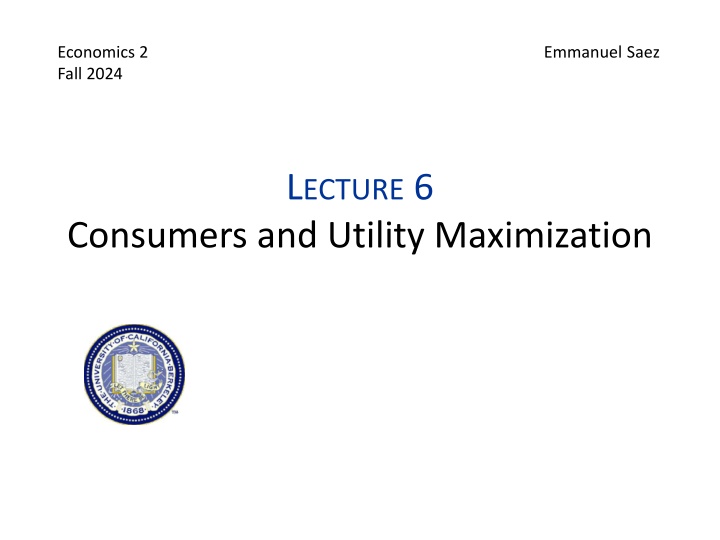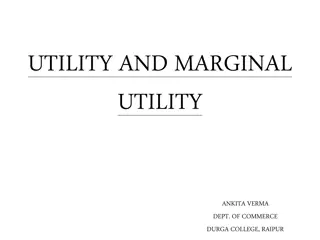Consumers and Utility Maximization
This lecture explores the importance of consumer optimization in understanding market outcomes and consumer choices. It delves into topics like budget constraints, household spending, income changes, and price effects on consumption decisions.
Download Presentation

Please find below an Image/Link to download the presentation.
The content on the website is provided AS IS for your information and personal use only. It may not be sold, licensed, or shared on other websites without obtaining consent from the author.If you encounter any issues during the download, it is possible that the publisher has removed the file from their server.
You are allowed to download the files provided on this website for personal or commercial use, subject to the condition that they are used lawfully. All files are the property of their respective owners.
The content on the website is provided AS IS for your information and personal use only. It may not be sold, licensed, or shared on other websites without obtaining consent from the author.
E N D
Presentation Transcript
Economics 2 Emmanuel Saez Fall 2024 LECTURE 6 Consumers and Utility Maximization
Why Consumer Optimization Is Important It has implications for how we view the desirability of market outcomes. It can help us to understand the many choices that consumers make.
A Households Budget Constraint In words: The total amount the household spends cannot exceed its income. In symbols: Pa qa + Pb qb + Pc qc + + Pz qz = Income, where the P s are the market prices of the various goods, and the q s are the quantities that the individual household buys.
Budget Constraint for the Case of Two Goods Pfood qfood + Pclothing qclothing = Income qfood qclothing
Budget Constraint for the Case of Two Goods Pfood qfood + Pclothing qclothing = Income qfood Intercept =Income Pfood Budget constraint Pclothing Pf??? Slope = Intercept = Income Pclothing qclothing
A Rise in the Households Income qfood Budget constraint1 qclothing
A Rise in the Households Income qfood Budget constraint2 Budget constraint1 qclothing
A Rise in the Price of Clothing qfood Budget constraint1 qclothing
A Rise in the Price of Clothing qfood Budget constraint1 Budget constraint2 qclothing Recall that the slope of the budget constraint is Pclothing /Pfood .
What point does the consumer choose on the budget constraint? qfood Budget constraint1 qclothing
What do we think consumers maximize? Happiness, satisfaction, utility. Economists don t make judgments about what gives people happiness. Preferences of individuals are sacred for economists and are revealed by their choices
Utility Total utility: The total happiness one gets from consuming a given amount of a good. Marginal utility: The extra utility derived from consuming one more unit of a good.
Diminishing Marginal Utility As a household consumes more of a given good, the marginal utility of the good declines. Canonical example is food: when hungry, an extra unit of food gives you a lot of utility when satiated, an extra unit of good gives you a lot less utility, eventually negative
Diminishing Marginal Utility marginal utility q
Diminishing Marginal Utility marginal utility mu q
Relationship between Total Utility and Marginal Utility Suppose u = f(q) where q is the quantity of some good a household consumes, and u is the total utility the household gets from consuming the good. Then mu = f (q) where mu is marginal utility f (q) is derivative of function f at point q
Recall about derivatives Function f(x) Derivative f (x) is the slope of function at x f (x)=(f(x+1)-f(x))/1 assuming that 1 extra unit is small Formal mathematical definition is: f (x) = limit of (f(x+e)-f(x))/e when e goes to zero In economics: marginal always means derivative (adding one extra small unit) so that we can use calculus
Relationship between Total and Marginal Utility total utility q marginal utility Marginal utility is the derivative of utility (slope of utility function) q
Marginal Utility Likely Declines at Different Rates for Different Goods Good a Good b mua mub qa qb
Marginal Utility Likely Declines at Different Rates for Different Goods Good a (food) Good b (clothes) mua mub mub mua qa qb
The Condition for Utility Maximization (the Rational Spending Rule) A household is doing the best that it can that is, it is maximizing its utility if: The marginal utility derived from spending one more dollar on a good is the same for all goods. Technical (but not substantial) assumption: people can fine tune the exact quantity they buy we can apply mathematical calculus
The Condition for Utility Maximization with Just Two Goods (Food and Clothing) $1 ?? $1 ?? ??? ??? = Where the P s are the market prices of the two goods and the mu s are the marginal utilities of an additional unit of the two goods for the household. This is the same as: =??? ??? ?? ??
The General Condition for Utility Maximization (the Rational Spending Rule) ??? ?? =??? = = ??? ??, ?? where the P s are the market prices of the different goods, and the mu s are the marginal utilities of an additional unit of the different goods for the household.
A Rise in the Price of Clothing Suppose the household starts with: =??? ??? ?? ?? If Pcrises, and the household didn t change its purchases, then: ??? ?? <??? ??
Diminishing Marginal Utility marginal utility mu q
A Rise in the Price of Clothing Suppose the household starts with: =??? ??? ?? ?? If Pcrises, and the household didn t change its purchases, then: ??? ?? The household will need to buy less clothing (and more food) until: ??? ?? <??? ?? =??? ??
Why Demand Curves Slope Down Substitution effect: When the price of a good rises, a household wants less of the good and more of other goods, because the good becomes relatively more expensive.
A Rise in the Price of Clothing qfood Budget constraint1 Budget constraint2 qclothing
Why Demand Curves Slope Down Substitution effect: When the price of a good rises, a household wants less of the good and more of other goods, because the good is relatively more expensive. if price increases, I buy something else Income effect: When the price of a good rises, a household wants less of all goods, because its budget constraint has changed for the worse. if price increases, I can t buy as much
Demand Curves Individual Household Market P P q Q
Demand Curves Individual Household Market P P d q Q
Household and Market Demand Curves The market demand curve is the horizontal sum of each individual household s demand curve. Because each household s demand curve (d) slopes down, the market demand curve (D) slopes down.
Demand Curves Individual Household Market P P d D q Q
Household and Market Demand Curves The market demand curve is the horizontal sum of each individual household s demand curve. Because each household s demand curve (d) slopes down, the market demand curve (D) slopes down. Because each household s demand curve is derived from optimizing behavior, the market demand curve is as well.
Blueberries may help prevent Alzheimer's, new research suggests 4:41PM GMT 13 Mar 2016 Scientists say the fruit is loaded with healthful antioxidants which could help prevent the effects of the increasingly common form of dementia Blueberries, already classified as a superfruit for its health boosting properties, could now also help fight dementia, new research suggests. The study shows the berry, which can potentially lower the risk of heart disease and cancer, could also be a weapon in the battle against Alzheimer's disease. Scientists say the fruit is loaded with healthful antioxidants which could help prevent the devastating effects of the increasingly common form of dementia. One study involved 47 adults aged 68 and older, who had mild cognitive impairment, a risk condition for Alzheimer s disease.
Positive News about Blueberries mu mu1 q
Positive News about Blueberries mu mu1mu2 q q1
Positive News about Blueberries An optimizing consumer sets: =???????? ??? ???? ??????? ??? ???? ????????????? ???????????? A rise in the mublueberries causes: ????????????? ???????????? >???????? ??? ???? ??????? ??? ???? The optimizing consumer will want to consume more blueberries at the same Pblueberries.
Positive News about Blueberries mu mu1mu2 q q1
Utility of Income Consumer has income c that is used to buy all sorts of goods: Pa qa + Pb qb + Pc qc + + Pz qz = c where c is total amount spent on consumption. This consumer optimization generates utility u(c) with u(.) an increasing function of c. The marginal utility of income is u (c), the slope of utility function u(c) = extra utility from having +$1 We expect u (c) to decrease with c which means that u(c) is concave in c.
Quiz 1: Question: Suppose UC Berkeley gives you an extra $500/month stipend this academic year. The extra stipend is most useful to you if: A. My current stipend is low ($1000/month) B. My current stipend is medium ($2000/month) C. My current stipend is high ($3000/month) D. It is equally useful to me in all A,B,C cases Answer based on YOUR feelings (not ECON2 theory)
Utility Function u(c) is increasing u(c) is concave (means u (c) is decreasing) Utility u(c) 0 $ consumption c
Utility Function u(c) is increasing u(c) is concave (means u (c) is decreasing) Utility u(c) Example: u(c)=log(c) u (c)=1/c 10% increase in c gives same utility whether c is high or low 0 $ consumption c























